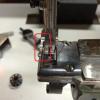-
Posts
5,750 -
Joined
-
Last visited
Content Type
Profiles
Forums
Events
Blogs
Gallery
Everything posted by Constabulary
-
I notice the hand wheel of your machine so I´d say it is from the 1960´s as it is a grayish-green color. The "more modern" Adler 30-1 have a massive hand wheel and are light gray. Check the thread / needle chart at the Toledo Sewing website. This will answer your questions I guess. http://www.tolindsewmach.com/thread-chart.html The needles you have will work with the thread you have. If you are sewing fabric look for 135x17 needles the 135x16 are for leather (as mentioned above). http://www.ebay.com/sch/i.html?_odkw=135x17&_sop=15&_from=R40&_osacat=0&_from=R40&_trksid=p2045573.m570.l1313.TR2.TRC1.A0.H0.X135x17+19.TRS0&_nkw=135x17+19&_sacat=0
-
The 794 is longer than the 328. 7x3 is just a different nomenclature for the 794 needle wit a round point tip, the7x2 needle has a leather tip. In case your machine is setup for 794 needles and you want to use 328 needles you have to lower the needle bar (if is possible at your machine but I think so). I think you should use just one needles system. I´d choose the one with the widest range of available needles sizes and tips but that of course depends on your dealer. Not sure where you are located but College Sewing in the UK has a lot of different 794 needles https://www.college-sewing.co.uk/catalog/search.aspx?keywords=794 and 328 needles https://www.college-sewing.co.uk/catalog/search.aspx?keywords=328 You probably have to refine the search at SERACH IN: and then choose NEEEDLES But I think one of the dealers who have banners on top of the page will have them both in stock as well.
-
Holy Cow - this is a really nice holster. I´m a bit US military crazy an like these holster more than any other. Do you has a stamp for the embosed US on the flap?
-

Home Made Speed Reducer For Singer 111W113
Constabulary replied to jjs111w's topic in Leather Sewing Machines
I always like creative solutions! The foot lifting mechanism is interesting. But you are not able to flip back the machine anymore, right? Never forget that you have to oil several spots in the bed era manually!!! -
Yes, I still have all parts. Not sure if it works on the 104. I know it has some kind of slot below the hand wheel but I don´t know for sure if it will fit. The Arm is about 19mm wide. The screw hole is about 5mm and I think the one on the 104 is larger but you can drill a wider hole in the bobbin winder arm, I think.
- 28 replies
-
- bobbin winder
- spare parts
-
(and 1 more)
Tagged with:
-

Outside Presser Foot Marking The Leather (Pfaff 335)
Constabulary replied to oclack's topic in Leather Sewing Machines
I personally would take the 227 but be aware that some do not have reverse but you will notice it for sure as the reverse lever is missing Big advantage is that the Consew 227 takes the Singer 111w / 153w type presser feet as it is based on the Singer 153w so you have a wide range of accessories to choose from. As you are buying from a dealer as it seems I´d test the machine before you take it home and I´d ask that he adjusts it for the thread you are using if necessary. The 227 can easily handle 138 thread!- 21 replies
-

Outside Presser Foot Marking The Leather (Pfaff 335)
Constabulary replied to oclack's topic in Leather Sewing Machines
you still have the back side of the foot that is holding down the material.- 21 replies
-

Outside Presser Foot Marking The Leather (Pfaff 335)
Constabulary replied to oclack's topic in Leather Sewing Machines
This is a picture from the new type 335 parts list but I think it should look the same in your machine:- 21 replies
-

Outside Presser Foot Marking The Leather (Pfaff 335)
Constabulary replied to oclack's topic in Leather Sewing Machines
I have no 335 parts list to show you a picture but when you open the face plate then there should be a clamp around the presser foot bar, it should be secured with one screw. Loosen the screw carefully (maybe 1/4 - 1/2 turn) and then turn the presser foot bar a bit to the right and then fasten the screw again. If you are unsure please post a close up picture of your machine with removed face plate. I just stumbled over this thread http://leatherworker.net/forum/index.php?showtopic=47557 Click on the pictures of the 335 - especially the 2nd one. This one has a needle plate with a bit more material on the left side. Maybe the machine has a different subclass but I think this is the needle plate you need!!!- 21 replies
-

Outside Presser Foot Marking The Leather (Pfaff 335)
Constabulary replied to oclack's topic in Leather Sewing Machines
Do you see that the left toe is shifting a bit to the left in the moment it hits the needle plate? I´d still look for a foot with a wider left toe and / or a different needle plate. Or try to adjust the presser foot bar a bit to the right the way that at the toe has more contact with the top of the needle plate.- 21 replies
-

Outside Presser Foot Marking The Leather (Pfaff 335)
Constabulary replied to oclack's topic in Leather Sewing Machines
Not sure what you mean with rotation... If you google for Pfaff 335 you will find pictures of other needle plates with a little more "beef" on the left side but they seem to be checkered and for tape binding and I don´t know if they will mark the leather on the underside. https://www.google.com/search?q=pfaff+335&hl=en&source=lnms&tbm=isch&sa=X&ei=gxsoVNGZOKufygOj-IHICA&ved=0CAoQ_AUoAw&biw=1280&bih=866#hl=en&tbm=isch&q=pfaff+335+needle+plate Maybe there are other variants... I don´t know what else is available for the 335. I´d check with one of the dealers who have banners on this website. Cylinder machines are for sure more versatile than flat beds but If you sew only flat items like wallets I think a flat bed machines is the better choice. I would not trade for a 31-15, thats a bad deal but for a 227 type machine I´d trade it immediately. Just my 2 cents.- 21 replies
-

Major Problems With New Sewing Machine
Constabulary replied to lranger's topic in Leather Sewing Machines
Can you add some pictures? Pictures often tell more than words. -

Outside Presser Foot Marking The Leather (Pfaff 335)
Constabulary replied to oclack's topic in Leather Sewing Machines
My thoughts about the 335 in general are that they were originally designed as tape binding machines and not as leather sewing machines. Most of the Pfaff 335 I have seen are set up as tape binding machines. I think the Consew 227 type machines or Pfaff 345 are the better leather sewing machines.- 21 replies
-

Outside Presser Foot Marking The Leather (Pfaff 335)
Constabulary replied to oclack's topic in Leather Sewing Machines
There is a very narrow and quite sharp angled piece of needle plate on the left and on this narrow piece of steel comes all the pressure of a very narrow left toe foot. What I want to say is that all the foot pressure is concentrated on small spot and this causes the marking. If you had a wider needle plate on the left and a wider left toe I think it "could" solve it but I don´t know if such parts are available for the 335. Or try a wider right toe foot and see if it solves the problem as there is "much more needle plate" on the right. You know what I mean? Your presser foot is barely touching the needle plate.- 21 replies
-

Singer 29K 171 Needle Alignment (W/ Pics)
Constabulary replied to thesergeant's topic in Leather Sewing Machines
But when he is sewing the needle will be deflected by the needle plate so when the needle meets the hook the needle has bit of an angle. So when the upper body will be slightly moved to the left it could solve the problem. See his 2nd picture. Or did I get it wrong? -

Singer 29K 171 Needle Alignment (W/ Pics)
Constabulary replied to thesergeant's topic in Leather Sewing Machines
It probably sounds radical but if shifting the body does not work I´d try to drill the screw holes a tiny bit wider and then shift the body again - you know what I mean? -
Have you bought the 2 machines?
-

Singer 29K 171 Needle Alignment (W/ Pics)
Constabulary replied to thesergeant's topic in Leather Sewing Machines
Have you separated the 2 cast body parts when you have restored the machine? Maybe you can try to loosen the 4 body screws and try to shift the upper body a bit to the left. Just an idea for the case nothing else works. But that will probably have an influence on your needle & hook... I´d buy another needle pate and drill or file the holes wider if you don`t want to damage the original part. -
If there is an original 45K Manual in the drawer then PLEASE scan it and post the file here. And in case you don´t need it I´d be interested in buying it Adler manuals are too big to upload here so here you have the direct download links, just click on them and the download will start automatically. The machines may look a bit different but the instructions are the same. Manual Adler 30-1 Mechanics Manual Adler 30-1 For the 45K I only have this: 45Kmanual.pdf
-
these machines were originally designed as shoe patcher / shoe repair machines. They are not meant as production machines for heavy leather.
-
Not sure what other 111 type machines can handle but my Singer 111G156 can handle 207 (size 15 Metric) thread w/o problems with a 23 (160 metric) size needle. There should be some good used machines out there. Maybe you should contact a local dealer or one of the dealers who have a banner on top of this website.
-

Latest Shipment Of Leather Machines
Constabulary replied to Singermania's topic in Leather Sewing Machines
I don´t think the GDR imported sewing machines from West Germany to re-sell them under their own brand name - doesn`t make sense. If it were the other way around then I´d say it is possible. -
@ Evo160K So your estimated sale price could be about 800 -1100 but then they should be fully functional. But when you buy them to make some money expect that you probably have to invest some money (in case the bobbin winders are missing and so forth) to put them back into a fully functional condition. Bobbin winders are an easy task - nothing you need special knowledge for. So if you can get them for about $200 each (or even less) you should be able to make a nice profit. At the end it is your decision. Keep in mind that you have to find a customer. But If I were you I´d buy them if the price is good.
-







